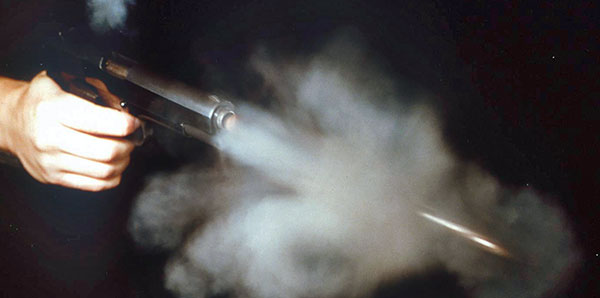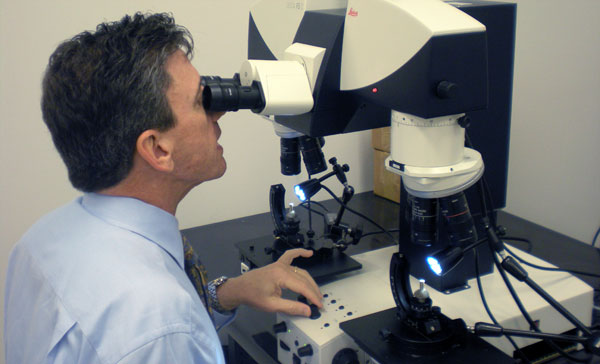How It’s Done
Firearms Evidence that May be Found
The range of evidence in firearms-related cases can be as small as a piece of a bullet fragment which has rifling marks or as large as hundreds of bullets and cartridge cases and numerous firearms. Even from small samples, information can be developed to indicate the type of firearm used and possibly identify the actual firearm that was used.
Other firearms evidence that could be found at a shooting scene includes shotshell wads and shot pellets; these can indicate the gauge of the shotgun. Wads and pellets can be gathered and preserved in the same manner as bullets and cartridge cases.
By examining wadding materials, the examiner may be able to determine
- the gauge of the shotgun
- the manufacturer or marketer
- a range of possible shot sizes based on impressions in the shotshell wad
- individual characteristics (in some cases)
Gunshot residues fall into two categories. The first type is gathered from the suspected shooter’s hands with a collection kit. The purpose of the examination is to determine if a person has recently handled or fired a weapon. Since it doesn’t determine which firearm was fired or when, this testing has limited value, and many laboratories have stopped performing these examinations. The second type looks for residues on items such as a victim’s clothing in an effort to determine the muzzle-to-target distance. Many times this type of evidence is not visible to the naked eye and requires microscopic examination and chemical testing to develop. The victim’s clothing must be handled with care, air dried and stored in paper containers in order to provide useful evidence.

Propellants and other gunshot residues expelled during the firing process. (Courtesy of Jack Dillon)
How the Samples are Collected
Firearms evidence can be recovered in a number of ways and areas. Firearms themselves can be recovered at shooting scenes by crime scene investigators and sent to the laboratory. Bullets, bullet fragments, cartridge cases, shotshell wadding, etc., are normally collected individually after proper documentation/photography and sent to the laboratory. Bullet evidence can also be obtained at autopsy or in an emergency room setting. In these cases the sample should be marked as a biohazard and then sent to the laboratory. Each laboratory has written procedures for packaging and submitting evidence.
Bullets/slugs that do not strike a person are often imbedded into a nearby surface such as wood/drywall. This evidence is best gathered by cutting out a section of the material and submitting it to the laboratory to allow a firearms examiner to carefully extract it. This prevents adding or destroying any markings that could be crucial to identifying or matching the suspected firearm.
Who Conducts the Analysis
A well-trained firearms examiner should perform the evaluation and comparison of this evidence. These examiners will have received extensive training on all matter of firearms and ammunition manufacturing; evidence detection, recovery, handling and examination procedures; comparison microscope equipment and procedures; courtroom testimony and legal issues; and casework.
The Association of Firearms & Tool Mark Examiners (AFTE), an international group of nearly a thousand examiners, has developed an examiner training course which takes 18 to 24 months to complete. Visit the online version of this training ▸ AFTE also offers a certification process for qualified AFTE members in three separate areas: Firearm Evidence Examination and Identification; Toolmark Evidence Examination and Identification; and Gunshot Residue Evidence Examination and Identification.
Most state crime laboratories in the US have a firearms examiner(s) on staff who can perform analysis for police departments within their jurisdiction if the need arises. Some police agencies have their own qualified examiner on staff.
How and Where the Analysis is Performed
Most examinations are performed by crime laboratory employees who are trained to conduct this type of examination. However, there are private laboratories/companies that can also perform this type of examination for a fee; often these are staffed by retired examiners. Whichever is selected, the evidence needs to be submitted for examination along with any firearms collected following the policies and procedures set down by the submitting agency.
Actual items of evidence are submitted to either crime laboratories or private laboratories according to the requesting agency’s policies and procedures. These items should be submitted in a manner that follows good chain-of-custody protocols.
The laboratory will have certain items of equipment available to conduct the examinations required. Measuring devices such as calipers and balances are used to weigh and measure bullet evidence. Stereo microscopes are used to determine basic class characteristics of fired bullets, bullet fragments and cartridge/shotshell cases. A comparison microscope is used for the examination of fired bullets, bullet fragments and cartridge/shotshell cases. Equipment used for the examination of firearms include the above items plus special equipment to measure the trigger pull of the firearm and examine the interior of the barrel. Also there must be facilities to test-fire the submitted firearm and recover fired bullets and cartridge cases. Most laboratories use a water recovery method, which is a large tank of water with a port into which the firearm is discharged. There are other systems used as well, such as metal boxes containing cotton waste material.

Examiner using a comparison microscope to analyze two .22 caliber casings. (Courtesy of NFSTC)